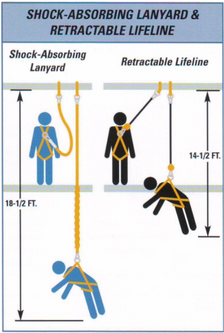What is a Self-Retracting Lifeline?
Over the years we have had a lot of questions about fall protection. It can have disastrous consequences if you don't have the right type. That being said, fall protection, in general, has been getting better and better. Here is a common discussion I have regarding SRL's.
What is an SRL? While some people believe SRL stands for Self-Retracting Lanyard, it really is an abbreviation for Self-Retracting Lifeline. Although that term may not mean much to you at first, it is actually a somewhat descriptive name because a self-retracting lifeline is just that, it retracts automatically.
What do you mean, self-retracting? What a lot of questions you ask. Well, the best way I can describe it is to think of a seat belt. We have all felt our seat belt jerk taut when we come to a sudden stop in our car. Even though there might be a lot of force, or energy, involved in a sudden stop, we generally do not feel the brunt of it.
How does a seatbelt limit the force of the stop? Seatbelts are designed to absorb energy by having a small amount of stretch in them. Some of the force of the sudden stop will dissipate with the stretching of the belt. Seatbelts are also designed to spread the force across your body, which is why they are worn across the body.
Okay, but what does this have to do with SRL's? An SRL uses the same basic principles as a seatbelt. The line will stop us from falling. Much like a seatbelt, an SRL absorbs some of the energy of the fall by having a braking mechanism that emulates the stretch of a seat belt. Your harness, like your seatbelt, is also designed to spread the force across your body by wrapping around you at both your shoulders and legs. Side note: You should always attach your SRL to the back D-ring of your harness.
That sounds great, but why should I get an SRL? Especially in applications where the anchor point is directly overhead, SRL's provide better fall protection than lanyards or rope grabs. Again, think of jerking a seat belt. The seat belt will not let you pull out more belt if it has been jerked. The same is true for an SRL; it will not allow more rope to exit the housing once it has been jerked. So if the SRL is anchored 3 feet above you or 10 feet above you, the fall distance will be the same: just the energy absorbing "stretch" of the braking mechanism.
How is this any different than using a lanyard? In the case of a lanyard, you will fall the distance from the work surface to the back D-ring, the length of the lanyard, then the stretch of the lanyard. With a 6 foot lanyard, this fall can amount to almost 20 feet. Even with shock absorbers, the speed gathered in a 20-foot fall will have a much more significant (and painful) impact on your body when you finally do stop. An SRL, when used appropriately, does not allow this build up of speed.
As always, if you are not sure what type of fall protection will be best for your application, feel free to contact us and ask!
Recent Posts
-
Promoting Safety: National Work Zone Awareness Week is April 15-19, 2024
Each year, the National Work Zone Awareness Week (NWZAW) places the spotlight on the importance o …Apr 11th 2024 -
Understanding 4 Gas Monitors: How They Work & Why They Are Important
In today’s increasingly dynamic industrial landscape, 4 gas monitors have emerged as critical com …Apr 8th 2024 -
April Showers Require Workers to Wear Hi-Vis Safety Rain Gear
While April showers bring May flowers, they also bring challenges, particularly for those working …Apr 1st 2024





